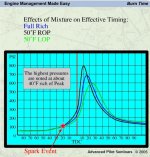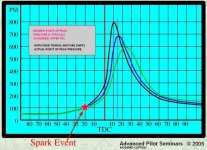The POINT I WAS MAKING (not re-hash the P-Mag debate) is HOT SPARK WARS.... You know you only need about 0.20 to 2mJ to ignite gasoline engine. 1 Joule is equal to 1 Newton over 1 meter. One Joule is equal to
1 joule per second or 1 kg⋅m2⋅s−3. One watt equal to one joule (J) per second: W = J/s. When we say mJ it is milli-Joule, milli or 1/1000th of a joule. Watts are also expressed in volts x amps. So the energy is very low but VOLTS very high to jump the gap. All ignition produce high voltage to make a spark jump the gap of the plug under high combustion pressures.... It is not that hard to get high voltage with a coil which has primary and secondary windings. Coils are transformers and not magic or special secret sauce. All EI's are using coils made for automotive industry, Ford, Chevy, Bosh, NGK, DENSO, MSD... They come in many forms, including Integral Ignition Coils that go directly on the spark plug. Cool. Most we see now are coil packs to drive 1, 2, 4, 6 or 8 spark plugs. P-Mag use two coil packs in one 4 plug tower, with the lost spark principle, very common and simplifies the system, timing, lower weight etc... Works well. Most EI's use lost spark. To have one dedicated coil per plug is "better" but overkill for a low RPM 4 stroke engine. It would add weight.
PMAG quote:
"High Energy Spark – When is enough… enough?
Ignition shoppers are sometimes encouraged (by our competitors) to compare the spark energy output of different electronic systems. The implication and challenge being, the greater the energy – the better the ignition. E-MAG has a distinctly different perspective that runs counter to some, if not most, in the industry. To explain, we’ll start with our own design objectives: Spark energy should be increased ONLY to the extent necessary to achieve the intended result – AND NO MORE.
This approach stems from a simple truth. The benefits of high energy spark are non-linear. Meaning, after an initial boost there is little or no benefit derived from more (and more) energy. There is, however, an increased burden in the form of additional heat, stress, wear, and weight associated with the creation and constraint of excess spark energy. These can be managed, but if the additional energy doesn’t produce a benefit – why do it in the first place?
E-MAG uses a closed-loop control to manage and regulate spark energy at predetermined (elevated) levels. Our energy output is a function of deliberate design choice – not a limitation of capacity. Again, the goal is to deploy the minimum energy required – not the maximum amount possible.
This energy strategy has other benefits. E-MAGs are smaller, lighter, and operate cooler than competitors. This allows us to mount directly on the engine . . . . where ignitions were designed to go. Even more important, direct mount provides the drive for E-MAGs built-in electrical power back-up . . . which is the “elephant in the room” when it comes to comparing and contrasting the merits of flight-critical electronic systems.
So the P-Mag is making way more spark energy than "needed" by a factor 8 to 20 times. There is a point of diminishing returns. The FORD EIS 4 cylinder tower coil can make 40,000 volts. Who cares if its' Ford or Chevy. P-Mag sizes the spark properly. You can vary the VOLTS and DURATION of the spark by adjusting the gap. Small gap lower volts (spark size) but gives longer duration, larger gap requires more voltage and shortens duration. The P-Mag sets NGK plug gaps to 0.035 and fires them easily, even in super lean conditions. More spark energy will have limited benefit, some but limited benefit. However for bragging rights people point to their big coil. Ha ha. I have SEEN one brand of EI and their "test" results which I find suspect? I am just saying. If I take it at face value, even if they claim over twice the spark energy, I go back to "so what"? Is that needed? May be in some Reno air race engine run well over red line it can benefit?
I would love another CAFE Foundation type test with many EI brands side by side in a controlled manner (aircraft flight test) and see how much difference their is. As I said Magnetos are not bad. Most of the benefit in EI's they all have: "hot spark" (more than enough), less or no moving wear parts, no points, no rotor, no distributor cap and the advanced timing gets you 90% of what is possible. Car test of multi strike top end MSD CD (Capacitive Discharge) ignitions adds 5 HP in 350 HP car engines peak power. That is a bit over 1% in extreme conditions (higher RPMs than an aircraft engine). Other factors such as induction, exhaust. Also as I said autopilot is like finding a few miles per hour block speed on a trip. Most pilots heading and altitude wonders when hand flying. Going stright and level is more efficient.
To get full benefit or pay back on investment on your EI you have to fly more than less at +8000 feet (10,000 feet better) and lean as much as possible (as allowed by engine manual). LOP with smooth engine is holy grail. Say you save $5 and hour on fuel. You spent $5000 on the EI. So pay back is 1000 hrs of optimal high flying low power LOP flying, Lets say half of your time is doing low power LOP optimal flying. That is 2000 hours total. You fly 100 hrs a year. That is 20 years pay back? .Regardless is less maintenance of an EI has value.
As was pointed out P-Mag recommends 100 hour bearing check as some defect or weakness. You pull it out and check for play. Put it in and time it easily, another P-Mag benefit, ease of timing. As I said the aftermarket EI Commander can monitor timing "jitter" which, according to EI Commander, indicates play in bearing. This is not P-Mag saying this but EI Commander, but they claim you never have to remove the P-Mag if you have this cockpit monitor. Personally having a look is good. It can be done in a few hours (assuming you already have the cowl off and doing other work). Plus P-Mag users with way more time on them report no wear after many 1000's of hours. The bearings are not expensive. Also I do believe the early bearings have long been up graded. I am pretty sure they do this to maintain price sensor gaps. It is not like a catastrophic failure just precise tolerance. It is a clear CON of the P-Mag it has direct accessory case drive which means you have to check it. It also is the PRO due to ease of installation and compact integrated design. No free lunch.
What if another ignition has 2 or 3 or 10 times the spark energy of another EI which functions fine? Great. That flame thrower ignition will uses more power, the electronic components including the coil (which can burn out) get HOT HOT HOT. Coil burnout is fatal and happens, but it is rare if you are not over saturating the coil with higher power input with huge spark plug gaps. Will an ignition hotter than the sun give better performance? Yes. How much. No one really has proved it by careful reputable experiments, observation, data, math, science, physics, and documented flight test. Not withstanding the bench test by one EI brand who does not disclose all the test parameters, all ignitions EVEN THE MAGNETO make plenty enough spark to make an engine go BANG, BLOW, SUCK, SQUEEZE and BANG again over and over. We (engine makers) have been doing this well over 100 yrs. Delco 1912 (Charles F. Kettering) first on a Cadillac. The HE EI's came out widely in mid 1970's and distributor less coil on plug EI's by the 1990's. It is old tried and true technology. BTW the old points coil ignitions worked. Hot spark but limited timing advance, all mechanical. EI was a big gain over that.
If you DESIRE the HOTTEST spark known to mankind... well P-Mag may not be it.
If the hour or two once a year/100 hrs (recommend) is too much for you than not for you. If you want easy installation and 99% of the benefit an EI with timing advance can give , with TRUE ELECTRICAL independence, ease of installation, than P-Mag is worth the look. The non technical side is Customer Service. E-Mag air has excellent support from near Dallas (central USA) and the staff is well suited to keep this company going for many decades more, even after Brad retires. Is it for everyone? No. It is right for me... Yes, I did THUNK about it, secure in my decision.
I am not going to point out short falls of other brands. Per the Kit Plane magazine article on ignitions I link to in previous post, there are many EI's. Some are certified some not. NOTE certified ones do have advance timing but do NOT allow user modification. No shock. I will say Magnetos are NOT garbage (but do require 500 hr service and really do wear, plastic gears, points, rotor, cap). The difference, true real world difference for the average RV builder with a stock Lycoming using a magneto vs EI flying a 100 hrs a year is going to be small. The difference between different EI brands in performance will also be small, but clearly some have more flash panel displays. Nice. All will give better overall performance over a magneto, easier starting, smoother running, ability to lean deeper and maintain smooth operations (if indication and exhaust are tuned properly).
I get the passion, favoritism and loyalty of one brand of EI over another. I have no dog in fight, I think they all have something to offer. They are all pretty cool.
The P-Mag just happens to be THE ONLY ONE that does not need a battery of any kind to run in flight, plus bonus is easy to install.









